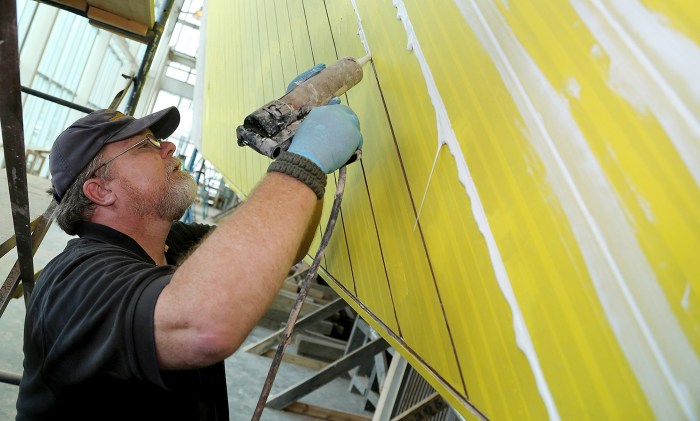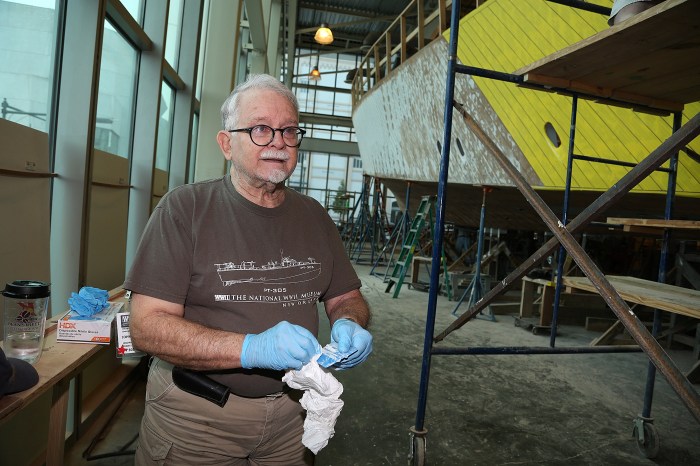
By George Morris
Baton Rouge architect Clifford Grout never met his grandfather, who died in a 1957 car accident, 18 months before Clifford’s birth. But almost every weekend at the National World War II Museum in New Orleans, grandson has grown closer to grandfather.
One tube of caulk, one paint brush stroke, one hammer swing at a time.
And he’s not alone. On any given Saturday, three generations of Grouts pay tribute to their forebear by helping restore one of the wartime vessels his work helped create.
John C. Grout was a purchasing agent for Higgins Industries when that New Orleans shipbuilder was cranking out incredible numbers of naval vessels during World War II. While many history buffs think only of the LCVP — so much a part of amphibious invasions these landing craft became known as “Higgins boats” — all sorts of maritime craft came out of his factories.
One of them was PT-305, a patrol-torpedo boat that served in the Mediterranean and is now being meticulously brought back to its former glory. It is nearing completion.
John C. Grout Jr., a retired workers compensation judge who lives in New Orleans, previously helped restore one of the many landing craft for the museum. When the PT boat restoration began, he invited his son to participate in 2010.
“I told Cliff, ‘You need to come do this. This is important stuff,’” he said.
Clifford Grout was reluctant.
“I was thinking, ‘Geez, to drive from Baton Rouge to New Orleans to work a couple of hours …’” he said. “I have no skills whatever in boat building. I’m a design guy. I’m an architect. I play with pencils, though now I play with computers. I do not have any type of marketable skill to build a boat.”

But restoring — essentially rebuilding — a 78-foot wooden boat has room for a lot of menial skills, so he went, and kept coming back. Sometimes, he brings his son, Jack, to help.
They join a small crowd of volunteers, including a good number of skilled craftsmen, starting with Bruce Harris, a master cabinetmaker and the PT-305 restoration coordinator. The restoration uses many of the original techniques and materials to create a PT boat that will be true to the original boats in exacting detail.
Because they were built of wood, PT boats were swift and maneuverable, able to harass larger, more fortified and more heavily armed warships and prey upon enemy freighters, barges and other support vessels. PT-305 sank two enemy boats and participated in the 1944 invasion of southern France.
After the war, PT-305 was sold and became an oyster boat, whose owners shortened its length to avoid certain Coast Guard regulations and replaced its powerful engines with more economical diesels.
The restored version will be the original length, and 1,500-horsepower Packard engines will give the boat its old speed. Everything on PT-305 will be operational except its weapons.

The eldest John Grout was one of about 30,000 Higgins employees during the wartime peak. He went on to work for Kaiser Engineers in Gramercy after the war, and kept memorabilia from his days at Higgins. Some of it was lost when John Grout Jr.’s home was flooded after Hurricane Katrina in 2005, but the family has saved a variety of items, including a company newspaper that shows the father being honored for his leadership of a war bond drive and the son in a Cub Scout uniform, a lapel pin and a colorized photo that shows the eldest Grout aboard a forerunner of the PT boat during a trial run on Lake Pontchartrain.
Like any family’s memorabilia, those have a meaning that others won’t be able to appreciate. Not so with PT-305, which will eventually go on permanent display at the museum.
“Touching this boat is about as close as I’ll get to touching my grandfather — touching the things he had, his business card,” Clifford Grout said. “It’s important for me that that go on for my children.”
So proud of both of you!!
LikeLike